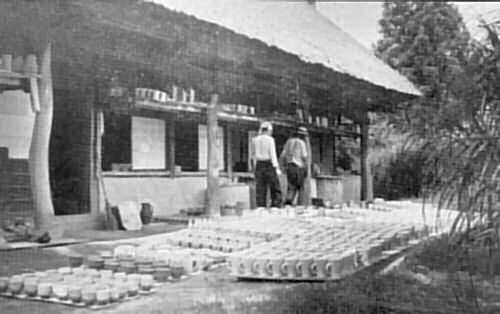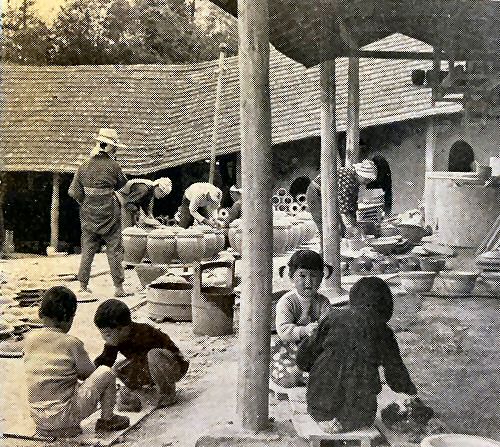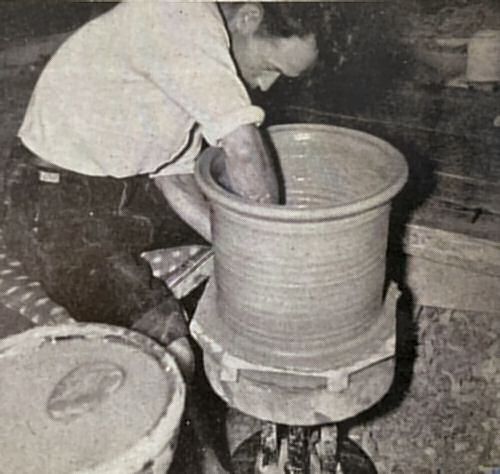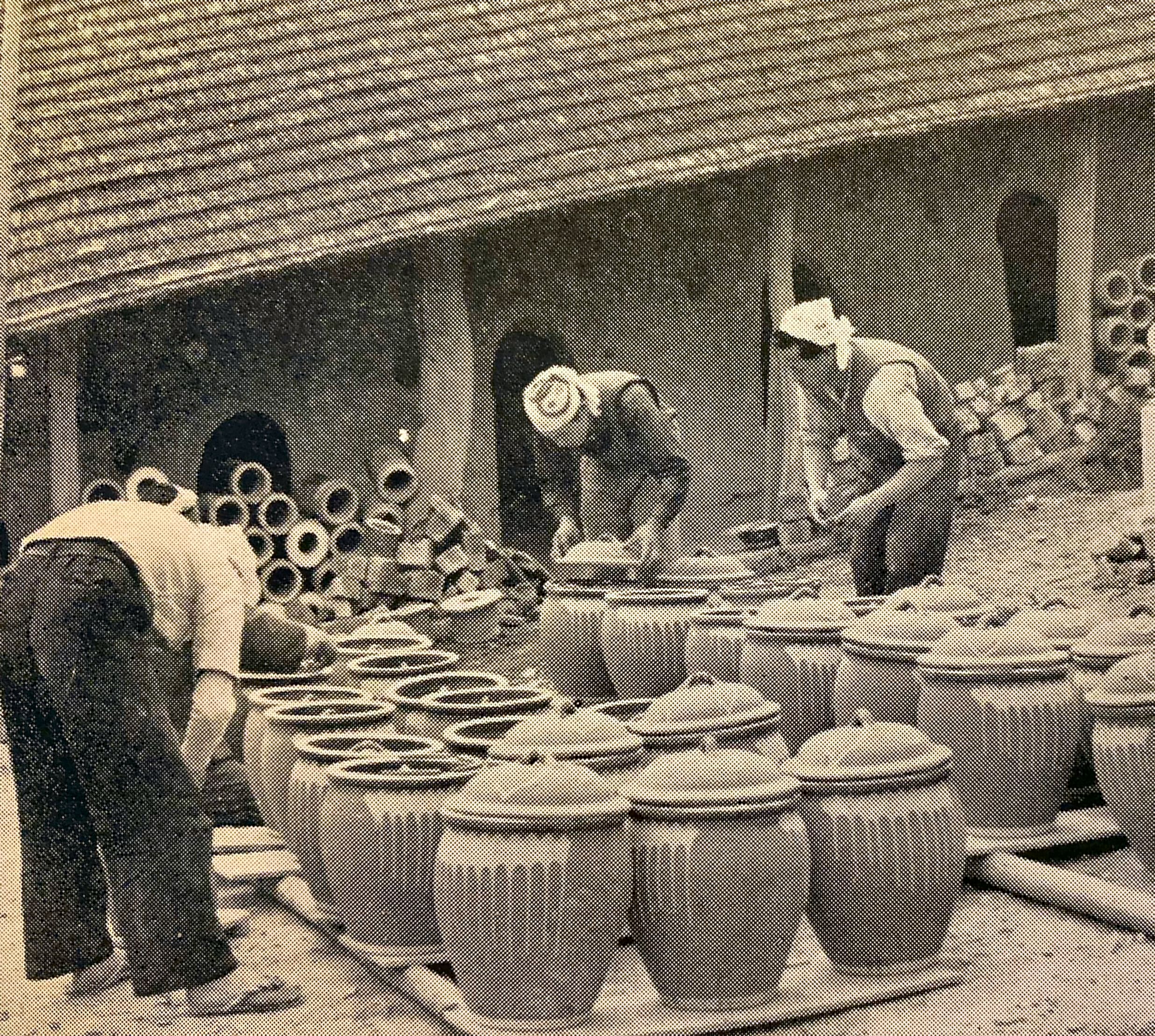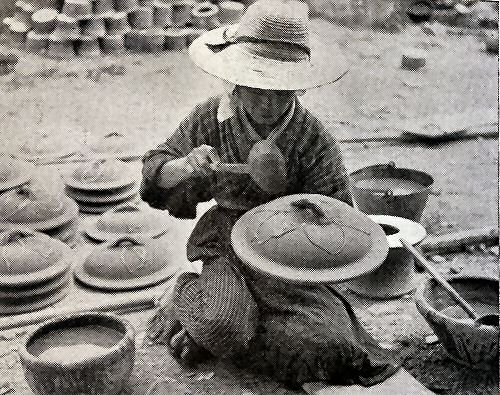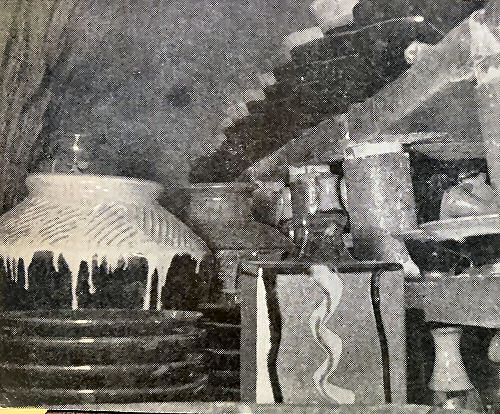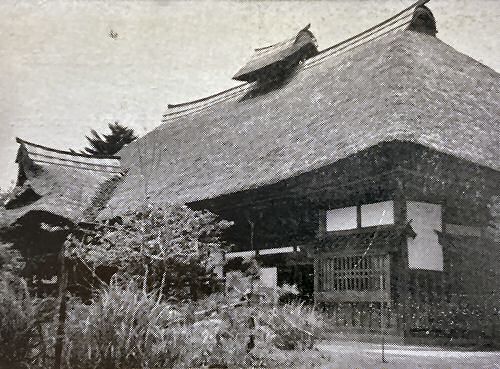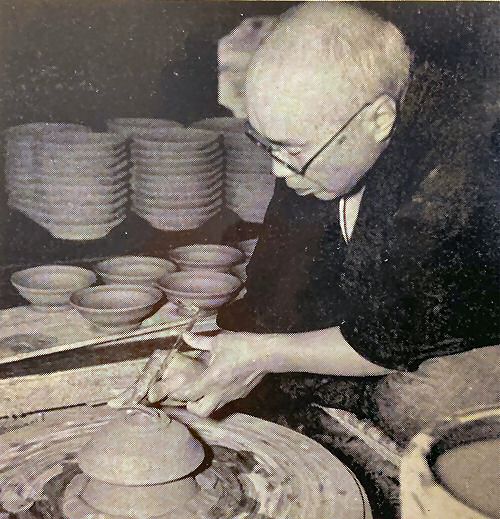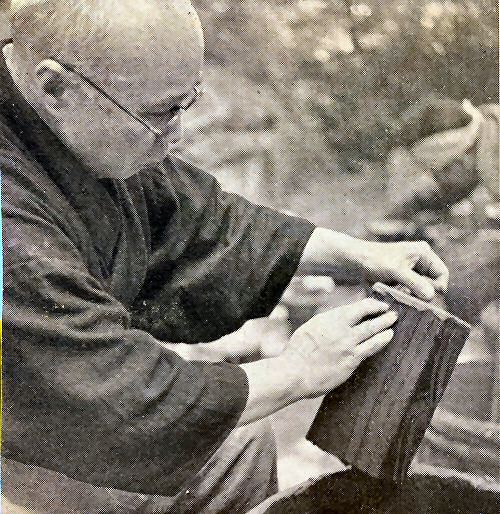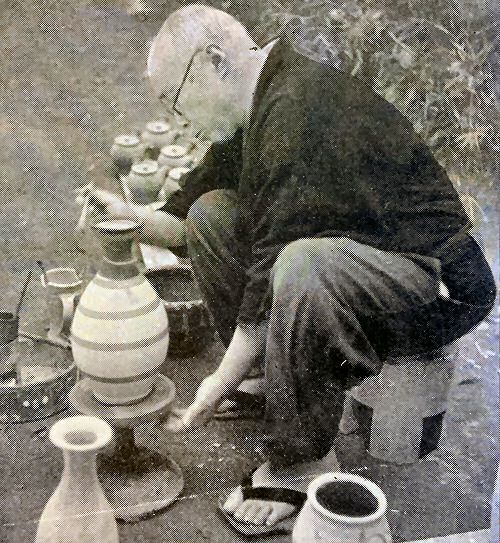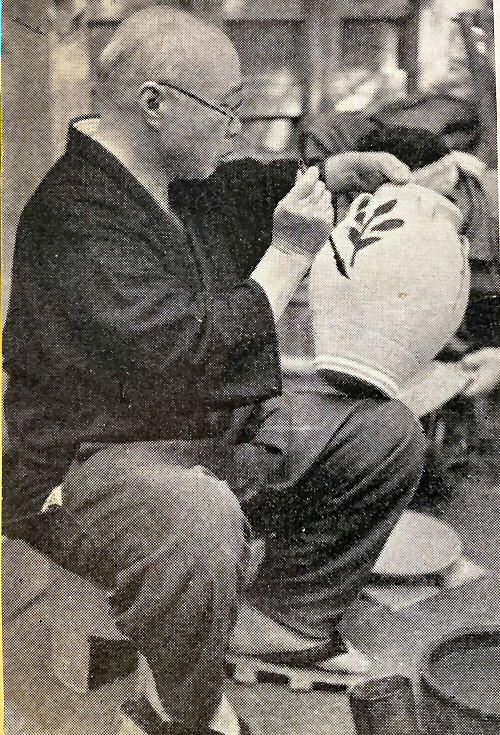Mashiko, the El Dorado of many Western potters, is a small
unpretentious village which has produced the kitchen ware for
Tokyo for about 250 years. It came into existence with the
establishment of Tokyo as the new capital, and potters travelled
north from one of the best old potteries in Japan (Karatsu, now
extinct) to found it on the remains of a pottery of a prior civilization.
The mountains in this area are gentle and well wooded and the
valleys are broad, making good rice fields. The potter and his wife
and family raise their own rice and foodstuffs as well as carry on
their work of potting. There is rarely a day when one does not see
a swirl of smoke rising from some kiln being fired. It was in this
simple remote community that Shoji Hamada chose to establish
himself upon his return to Japan after having worked with Bernard
Leach when the St. Ives pottery was being established. Hamada
could have had a much higher position had he chosen to make his
life in one of the cities, for he was a graduate of one of the best
technical schools of Western ceramic science in Japan and had
served as a professor before coming to England to work with Leach.
But he wisely chose the more wholesome background of a
traditional rural pottery and spent the first five years developing his
own work whilst using the workshops of these potteries. Slowly
and surely he grew, acquiring inner strength and assuredness before
he built his own kiln and workshop. Now his home is quite
imposing. His houses, examples of the best architecture of the
area, are built of adobe-like stucco and huge wooden beams with
heavy thatched roofs two feet thick. His gardens are informal;
and tucked inconspicuously along paths are outstanding examples
of Korean sculpture. His love for the beauty of the traditional
buildings has led him to acquire them, but his life has remained
simple and over all hangs the air of work as related to life, beauty
coming from the daily way of things.
The day of my arrival at Hamada's was a memorable one, for
they were in the midst of glazing and stacking his large eight-
chamber climbing kiln. Never had I seen so many pots being
handled in so deft a manner. Hamada, his two sons and about six
workers were in a veritable forest of pots.
The workshop is about 30 x 100 ft. long with a larger ground
area in front where pots are dried, and down a steep slope are his
largest kiln and another storage building. The working area under
the kiln shed is about 50 x 50 ft. The entire ground space of all
buildings and the adjoining area outside and along the sloping path
was thickly covered with boards full of pots! Nowhere was there
a clear pathway for walking; men with boards of pots over their
shoulders were nimbly stepping over and around other workers with
boards-a nimble weaving over and under in a long-rehearsed
performance.
All glazing was done on the ground, either bending over large
wash tubs pouring with a ladle, dipping or squatting to decorate
and to wash the bottoms of pots. Everyone seemed to know what
to do and glided from job to job, anticipating each need and
process beforehand. Hamada does all the decoration on his own
pots and more than half of it on stock items, in addition to
indicating what is to be done to the others and instructing as to
glazes and their treatment. I watched him decorate more than five
hundred pots with wax and glazes in one day, sitting on a low stool
with pots around him on the ground.
His best pots were reserved till late afternoon, for the more he
worked the more vigour he had. The work was feeding him rather
than draining him. His decorating techniques are principally that
of glazes over glazes; sometimes over a thin yellow ochre slip, often
with a wax pattern brushed on the first glaze; and his best-known
technique is of trailing a large glaze pattern with a dipper. His
brushwork is excellent, but he uses it only in a large sweeping
pattern.
About five thousand pots were in this firing, many quite large,
and most of the glazing, decorating and stacking was done in three
working days. This number of pots represented less than two
months' work (including bisque firing) by the two throwers (who
have worked for him nearly fifteen years), his two sons and himself.
The kiln firing lasts two days, and the sight of men stoking small
split sticks of pine into each chamber successively, with the resultant
belching flames and smoke from the port holes, is highly dramatic.
The temperature reached is about 12500C. No cones are used,
temperature and heat dispersion being judged by eye. The firing is
oxydised throughout the kiln, with the exception of the first
chamber, which always tends to be neutral to reduced in the
climbing kiln. In this chamber he uses different glazes, such as
the runny treacle-like one, with the pots set on shells for stilts.
The kiln was allowed to cool a day before opening. Two full days
were needed to unload, sort and instruct the packer as to shipments;
two more days to finish grinding bottoms of pots with hand stones,
stack saggars and clean the kiln floor and working area. Hamada
owns two kilns, one of five medium-sized chambers and a much
bigger one of eight large chambers. He averages firing either one
or the other of these every six weeks. Whilst I was there he also
began his experimentation with salt glazing, using the last chamber
of the small kiln. Almost no salting has been done in Japan.
To my eyes, his work cycle represented a miracle, without
taking into consideration the quality of the ware. He prefers not
to spoil the working atmosphere by the use of mechanical equip-
ment. The spirit surrounding the pottery is relaxed and free.
Hamada has a hearty ease about him which passes on to the crew
and is reflected in the pots as well. There are few seconds, but
there is also little apparent concern over the "imperfections of
nature," and their thinking has not been influenced by our imposed
standardization. Slick uniformity is not their conception of quality.
In rural Japan there is no Sunday, work is continuous until
firings. During the kiln watching, cooling and opening there is a
relaxed period of semi-holiday before preparations start for the next
session of work.
The workshop is a long stone and plaster building with a thick,
high-pitched thatched roof. This overhangs the building by about
six feet, providing under its eaves ample space for vats of glazes and
materials and drying racks. Along the entire length of the front of
the building are sliding, paper-covered windows which give the most
pleasing light I have ever worked in. There are racks along the
back wall as well as overhead, everywhere. In the centre of the
earth floor is a bricked depression, two feet square and a few inches
deep. This, the fireplace, serves as a source of heat to dry pots,
sandals and oneself; and, as everywhere, there is a black kettle
suspended over it. Running the length of the building under the
windows is a bench-like structure about two feet high and six wide.
This built-in platform is the only working area other than the earth
floor. No other tables, stools or benches exist. Interspaced along
this structure are thirty-inch-square embrasures which accommodate
eight potters' wheels. Some are Korean type kick wheels; others
are hand wheels turned with a stick.
Clay is delivered by horse and wagon from an adjoining
claymakers' village where it has been washed, sieved and dried,
ready to be kneaded. The men mix large mounds of it with their
bare feet on the earth floor of the shop. At the conclusion of the
mixing, it is left on the floor in heaps about 3 x 3 x 3 ft. Slices of
between thirty and fifty pounds are cut off and kneaded on the edge
of the platform next to the wheel. Their manner of rolling and
kneading, though arduous, is not as strenuous as ours. They never
lift the bulk of clay, and when their final hand-kneading is
completed the resultant rolls of clay are already in a convenient
working position for the wheel. If the clay is too soft, large pats
of it are thrown against the stone wall outside underneath the
windows and a board is placed on the ground to catch it when it
dries and falls off.
In every stage of work there is a natural flow of convenience
and availability without intellectual planning and organization.
They intuitively use the elements and materials supplied by nature
around them. A wad of dried straw rolled and tied makes the best
brush I have ever seen for washing the bottoms of pots; a similar
brush is made for kiln washing, the shelves and saggars. Straw
alone is used for packing, and the packer makes much of his rope
as he proceeds. Pots are dried in the sun and wind. Glazing is
done outside, so that no thought has to be given to drying the pots
before firing in the slowly heated kiln. Miscellaneous bowls,
utensils and boards are set out to be washed when it rains. All of
this results in a kinship and a flow of the work with nature.
The Korean kick wheel is a diminutive version of the
Normandy wheel. Its construction is simple, consisting of two
circular wooden discs, about fifteen inches in diameter and four
thick, joined by four posts, making a unit about twenty inches high,
which turns on a pointed spindle set into the earth. The wheels
are located centrally in the embrasures in the platform, with which
the wheel head is level. The potter sits on the edge of the structure
with his feet (usually bare) in the hole and kicks the lower disc.
Some rotate the wheel clockwise by pulling forward with the right
foot and toes. The hand wheel, consisting of one disc about
twenty-eight inches in diameter, is invariably turned clockwise for
greater power. The same tendency has been carried to the kick
wheel, although it is not considered theoretically correct There is
much less power in both these lightweight wheels than in any
Western types; but, as with everything else in Japan, the work is
not accomplished so much by power or push. Most of the work
is done from a ten- to fifteen-pound mound of clay. Larger pots
require centring equally as much, but this is achieved by deft
persuasion rather than power.
As I watched the throwing-whether by Hamada, or one of
his men, or any of the numerous throwers in the traditional potteries
along the roads of Mashiko-the realization was always the same:
the skill and fluidity of movement and the work resulting are the
outcome of an approach which is foreign to us. Their pots are not
made, they flow. This is best described by such words as ease,
naturalness, attunement, non-aggressiveness, and so on.
There is a harmony of living and working. Work is not
merely work; it is life. Whatever a man does he does with
his whole being, without self-consciousness or even awareness
of physical discomfort or fatigue. When he is throwing, he is
completely in his work; when he stops for a smoke he stops
completely. He takes long breaks for tea and chats; he plays with
the dog, watches a butterfly or picks a flower to put beside his
wheel. But there is never a half-way attitude; always an all-ness
of his whole being. This results in clean, sure movements - just
enough, without indecision or fiddling. Pots grow, are cut and set
off; grow-cut-set off with a rhythm of respiration.
When Hamada is throwing, it is obvious that he is
conscious only of the nature of the material he is using-clay-
and the form he is envisioning. There are no repressions
or regulations governing accuracy or precision relating to the
machine. He is striving for the spirit of the form in clay, the pot
comes up and at the first spontaneous burst of life he stops working
it. It may not be quite smooth, even, or centred; but these factors
are secondary and he does not sacrifice spontaneous vitality for the
sake of mechanical slickness and perfection.
When discussing glazes with Hamada (he knows more about
glaze chemistry than most Western potters) he commented to me
that on his recent tour through England and America many potters
thought him to be a simple peasant because he used only wood ash,
ground stones, feldspar and rice husk ash for his glazes, whereas
Western potters use long lists of chemicals and measure them by
molecular weight. He chuckled and said: "They think they are
being very complicated and I very simple, but in truth it is I who
am the more complicated, for I am using nature's mixtures, which
are infinitely more complex."
It is difficult to convey the full meaning of these people's
attunement to life and work; but in this atmosphere of natural
living and work one does not ask "How do you do this or that?";
one just does it, and it works. It is my opinion that Hamada was
wise enough to realize the true value of a living tradition, for it has
supported him and allowed him to grow to heights of maturity
which could hardly have been accomplished in unsympathetic.
unfertile soil.

